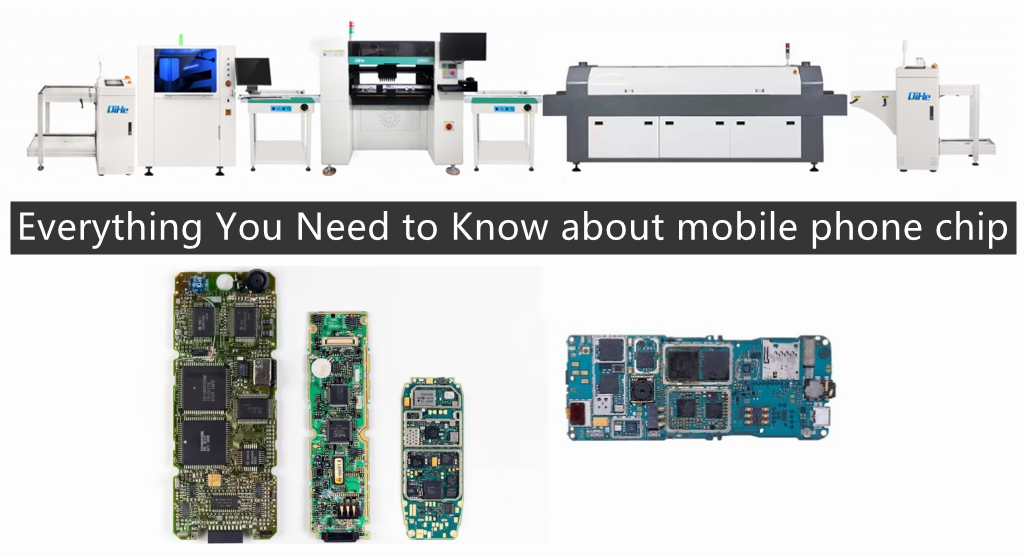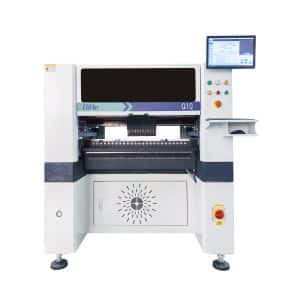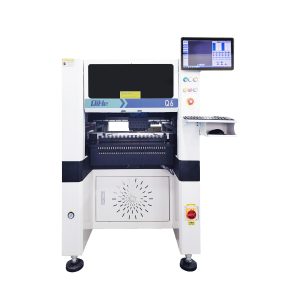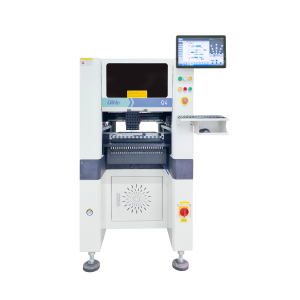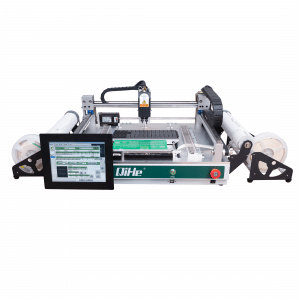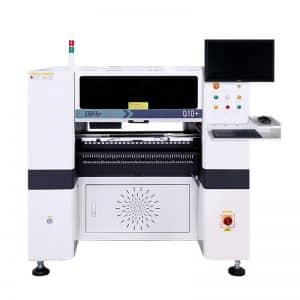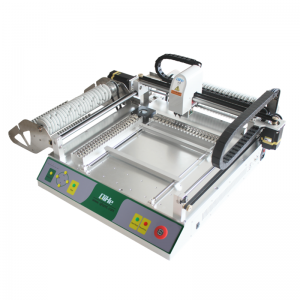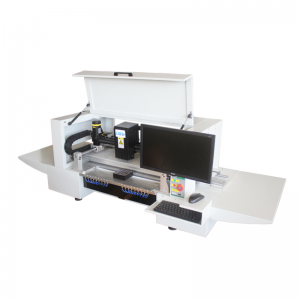The spectrum of wireless communication is limited and the allocation is very strict. Electromagnetic waves of the same bandwidth can only be used once. In order to solve the problem of too many people, engineers have developed many “modulation technologies” (Modulation technology) and “Multiplex technology” (Multiplex) to increase the number of Spectral efficiency, hence the invention of 3G, 4G, and 5G different communication generation technologies. So what components in our mobile phones are responsible for processing these technologies for us? Today qihe smt pick and place machine sharing basic frequency, intermediate frequency, radio frequency components and other knowledge allow you to understand mobile phone chips at once .

Modulation Technology and Multiplexing Technology
First of all, we need to understand that “modulation technology (Modulation technology)” and “multiplex technology (MulTIplex)” are completely different things. Let us first take a look at what is the difference between them?
Digital signal modulation technology (ASK, FSK, PSK, QAM): Modulate analog electromagnetic waves into different waveforms to represent two different digital signals, 0 and 1. ASK uses amplitude to represent 0 and 1, FSK uses frequency to represent 0 and 1, PSK uses phase (waveform) differences to represent 0 and 1, and QAM uses both amplitude and phase (waveform) differences to represent 0 and 1.
Well, the digital signals 0 and 1 that everyone’s mobile phone antenna wants to transmit have become electromagnetic waves of different waveforms. The question arises again. With so many electromagnetic waves of different waveforms thrown into the air, how to distinguish which ones are yours (and You are speaking), and those are mine (with me)?
Multiplexing technology (TDMA, FDMA, CDMA, OFDM): Divide electromagnetic waves to different users. TDMA uses time to distinguish whether it is yours or mine, FDMA uses different frequencies to distinguish whether it is yours or mine, CDMA uses different codes (orthogonal spreading codes) to distinguish whether it is yours or mine, OFDM uses different regular Subcarrier frequency to distinguish between yours and mine.
It is worth noting that regardless of the digital signal modulation technology or the multiplexing technology, it is performed together when the digital signal (0 and 1) is calculated and processed. Generally, the multiplexing technology is performed first and then the digital signal modulation technology (except OFDM), so multiplexing technology and modulation technology must be used at the same time.
Digital modulation technology (Digital modulation)
The current mobile phone belongs to “digital communication”, that is, the sound of our speech (continuous analog signal), which is first converted into discontinuous digital signals of 0 and 1 by the mobile phone, and then converted into electromagnetic waves (analog signal) carrying a digital signal), and finally sent out from the antenna,
Digital Communication System Architecture
Voice upload (talking on the phone): The sound is received by the microphone as a low-frequency analog signal, converted into a digital signal through a low-frequency analog-to-digital converter (ADC), and then compressed (Encoding) and looped through the “Baseband Chip (BB)” Repeat check code (CRC), channel coding (Channel coding), interleaving (Inter-leaving), encryption (Ciphering), formatting (Formatting), and then perform multiplexing (Multiplexing), modulation (Modulation) and other digital signal processing ,
Next, it is converted into a high-frequency analog signal (electromagnetic wave) through an “intermediate frequency chip (IF)”, which is a high-frequency digital-to-analog converter (DAC); finally, it is converted into a high-frequency analog signal (electromagnetic wave) through a “radio frequency chip (RF)” to form electromagnetic waves of different times, frequencies, and waveforms. transmitted by the antenna.
Voice downloading (listening to phone calls): The antenna receives electromagnetic waves of different times, frequencies, and waveforms, and processes them through a “radio frequency chip (RF)” to obtain a high-frequency analog signal (electromagnetic wave), which is then processed by an “intermediate frequency chip (IF)”. A high-frequency analog-to-digital converter (ADC) converts the digital signal.
Next, the “baseband chip (BB)” is used to perform demodulation (De-modulation), de-multiplexing (De-multiplexing), de-formatting (De-formatting), decryption (De-ciphering), and de-interleaving (De -inter-leaving), channel decoding (Channel decoding), de-cyclic repetitive check code (CRC), data decompression (Decoding) and other digital signal processing, and finally converted into a low-frequency analog signal through a low-frequency digital-to-analog converter (DAC) (sound) played by a microphone.
Data communication (Internet access): Basically, data communication, whether uploaded or downloaded, is a digital signal, so it can be processed directly by the baseband chip (BB). The other processes are similar to voice communication and will not be described again here.
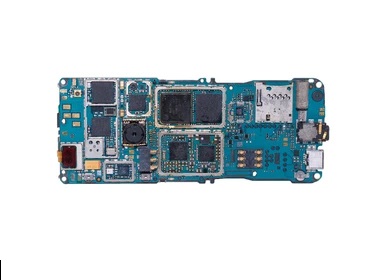
Wireless communication system architecture
Based on the previous introduction, let’s take a look at several important integrated circuits (ICs) in smartphones, which mainly include: base frequency (BB), intermediate frequency (IF), and radio frequency (RF), as shown in Figure 3 , each part may have one to several integrated circuits (ICs), or several integrated circuits (ICs) may be packaged into one, which is called “System in a Package (SiP)”, or Several chips are integrated into one, called a “System on a Chip (SoC)”.
Baseband chip (Baseband, BB): It is a digital integrated circuit used for digital signal compression/decompression, channel encoding/decoding, interleaving/deinterleaving, encryption/decryption, formatting/deformatting, and multiplexing. /Demultiplexing, modulation/demodulation, as well as management of communication protocols, control of input and output interfaces and other computing tasks. Well-known mobile phone baseband chip suppliers include: Qualcomm, Broadcom, Marvell, MediaTek )wait.
Modulator (Modulator): Converts the digital signal processed by the baseband chip into a high-frequency analog signal (electromagnetic wave), so that it can be transmitted very far. People who want to learn more about communication principles can refer here.
Mixer: Mainly responsible for frequency conversion, converting the modulated high-frequency analog signal (electromagnetic wave) into the required frequency to match the frequency range (wireless spectrum) of different communication systems.
Synthesizer: Provides the operating frequency required for wireless communication electromagnetic waves and radio frequency integrated circuits (RF IC), usually through a “Phase Locked Loop (PLL: Phase Locked Loop)” and a “Voltage Controlled Oscillator (VCO: Voltage Controlled Oscillator) )” to provide precise operating frequency.
Band Pass Filter (BPF): Only high-frequency analog signals (electromagnetic waves) in a specific frequency range (frequency band) are passed through, filtering out unnecessary frequency ranges to obtain the frequency range (frequency band) we need.
Power Amplifier (PA): Before high-frequency analog signals (electromagnetic waves) are transmitted, they must be amplified by a power amplifier (PA) to enhance the signal before it can be transmitted far enough.
Transceiver: Responsible for transmitting (Tx: Transmitter) high-frequency analog signals (electromagnetic waves) to the antenna, or receiving (Rx: Receiver) high-frequency analog signals (electromagnetic waves) from the antenna.
Low Noise Amplifier (LNA): Used when receiving signals. The high-frequency analog signal (electromagnetic wave) received by the antenna is very weak, and the signal must be amplified by the Low Noise Amplifier (LNA) before it can be processed.
Demodulator (Demodulator): used when receiving signals to convert high-frequency analog signals (electromagnetic waves) into digital signals, and then transmit them to the baseband chip (BB) for digital signal processing pick and place machine
Therefore, the principle of mobile phone uploading (talking on the phone) is: first, the baseband chip (BB) processes the digital voice signal, and then converts it into a high-frequency analog signal through the modulator (Modulator), and converts it into the required signal by the mixer (Mixer). The frequency, the high-frequency analog signal (electromagnetic wave) of a specific frequency range (frequency band) is obtained by the band-pass filter (BPF), the signal is enhanced by the power amplifier (PA), and finally transmitted to the antenna output by the transmitter receiver (Tx).
On the contrary, the principle of mobile phone downloading (listening to the phone) is: first, the high-frequency analog signal (electromagnetic wave) is transmitted by the antenna, received by the transmission receiver (Rx), and then obtained by a band-pass filter (BPF) in a specific frequency range ( Frequency band) high-frequency analog signal, the weak signal is amplified by the low noise amplifier (LNA), converted into the required frequency by the mixer (Mixer), converted into a digital voice signal by the demodulator (Demodulator), and finally The digital voice signal is processed by the baseband chip (BB).pick and place machine
Communication-related integrated circuits: base frequency, intermediate frequency, radio frequency
The back end (Back end) of the wireless communication system introduced above uses a baseband chip to process digital signals, and the integrated circuit (IC) used in the front end (Front end) can be roughly divided into two types: “RF chip” and “IF chip”. Large categories, respectively made of wafers of different materials:
Intermediate Frequency (IF): Also known as “Analog baseband”, it is conceptually “high-frequency digital-to-analog converter (DAC)” and “high-frequency analog-to-digital converter (ADC)”, including : Modulator (Modulator), demodulator (Demodulator), usually IF amplifier (IF amplifier) and IF bandpass filter (IF BPF), etc., usually composed of CMOS components made of silicon wafers, which may be digital integrated circuits, some of which may be integrated into an integrated circuit (IC).
Radio Frequency (RF): Also known as “Radio Frequency Integrated Circuit (RFIC)”, it is the general name for all chips that process high-frequency wireless signals, usually including: Transceiver, Low Noise Amplifier (LNA), Power amplifier (PA), bandpass filter (BPF), synthesizer (Synthesizer), mixer (Mixer), etc., usually MESFET and HEMT components made of gallium arsenide wafers, or BiCMOS made of silicon germanium wafers Components, or CMOS components made of silicon wafers. Currently, power amplifiers made of gallium nitride (GaN) are also used. They may be several integrated circuits, and some may be integrated into one integrated circuit (IC).pick and place machine,
maybe you want know more about ,SMT pick and place machine,smd machine,SMT equipment,pick and place machine,reflow oven,stencil printer,pnp,pick&place machine,pick&place,p&p,pcb assembly,smd chip shooter,pnp machine,smt setup,smt process,smt meaning,smt line,smt mounter machine,smt nozzle,pick and place feeder,smt line,used pick and place machine,smt assembly,smd package,smt machine supplier,pick and place machines,used pick and place machine
Read more: Everything You Need to Know about mobile phone chipBest seller SMT Machine :Qihe smt line products
-
SMT semi-automatic pick and place machine with Dispenser
-
TVM925 SMT pick and place machine 4 head 38 feeders slots assembly of electronic components
-
Q10 SMT Automatic pick and place machine 10 Heads 100 Slots High Precision and High Efficiency SMT/LED Assembly
-
Q6 SMT pick and place machine 6heads 50slots With PCB Rail Servo Pick&Place Machine
-
Q4 SMT pick and place machine 4heads 50slots With PCB Rail Servo Pick&Place Machine
-
TVM802B Plus SMT pick and place machine 2heads 58slots desktop pick&place deluxe edition
-
QM10 SMT pick and place machine 10heads 80slots Fully Automatic Chip mounter SMT Assembly
-
TVM802BX SMT pick and place machine 2heads 46slots desktop pnp mounter deluxe edition
-
QL41 SMT pick and place machine 4heads 8slots LED for 1.2meters led strip pick&place machine
What is SMT in engineering?
Surface mount technology is a part of the electronic assembly that deals with the mounting of electronic components to the surface of a PCB. Electronic components mounted this way are called surface-mounted devices (SMD). SMT was developed to minimize manufacturing costs while making efficient use of board space.Qihe SMT company develops and produces all kinds of SMT equipment suitable for world wide market, including pnp machine,reflow oven,stencil printer,pcb handling machines,and other products.
Small desktop pick and place machine TVM802A,TVM802B,TVM802AX,TVM802BX series suitable for beginners, for hobbiest or low vol usag.
Advanced level 4-head LED strip placement QL41 led machines and with rail universal series TVM925S,TVM926S,
Fully automatic 6-10-head placement QM61,QM62,QM81,QM10,machines, which are suitable for high volume mass production in factories.
Know more about us https://www.qhsmt.com/about-qihe-smt-equipment/
Follow us on social media https://www.facebook.com/Qihesmt/
What is SMT in programming?
Offline Automated Programming vs Inline SMT Programming
Qihe pick and place machine can be programmed directly on the SMT equipment .
Or Coordinates can also be imported csv file through programming software.
Currently supported software such as protel,DXP,Altium Designer,Pads,Candes,proteus,DXP.
Inline SMT programming is a solution to consider for narrow segments of device programming requiring short programming times, with medium to high volume, for just one device type.
WHAT IS SMT pick and place machine?
SMT (Surface Mounted Technology) is a comprehensive system engineering technology, which covers substrates, design, equipment, components, assembly processes, production accessories and management. When it comes to SMT pick and place machines, the automatic SMT production line requires automatic loading and unloading machine, automatic solder paste printing machine, placement machine, reflow soldering machine, AOI inspection equipment, conveyor,connecting table, etc. For these SMT assembly line equipment, Qihe SMT can offer you machines in prototype SMT line, small SMT production line, mass production SMT line at low SMT line cost. Contact us now if you are interested.
SMT pick and place machine,smt machine,smd machine,SMT equipment,pick and place machine,reflow oven,stencil printer,pnp,pick&place machine,pick&place,p&p,pcb assembly,smd chip shooter,pnp machine,smt setup,smt process,smt meaning,smt line,
smt mounter machine,smt nozzle,pick and place feeder,smt line,used pick and place machine,smt assembly,smd package,smt machine supplier,pick and place machines,
WHAT IS SMT ASSEMBLY LINE?
With the development of technology, future electronic products will be lighter, smaller and thinner. Traditional assembly technology can no longer meet the requirements of high-precision and high-density assembly. A new type of PCB assembly technology-SMT (Surface Mount Technology) has emerged. SMT Assembly is the use of automated machines to assemble electronic components on the surface of the circuit board. Its density, high speed, standardization and other characteristics occupies an absolute advantage in the field of circuit assembly technology. In addition, SMT assembly has a wide range of uses.
https://www.qhsmt.com/fully-automatic-smt-pick-and-place-machine-line/

